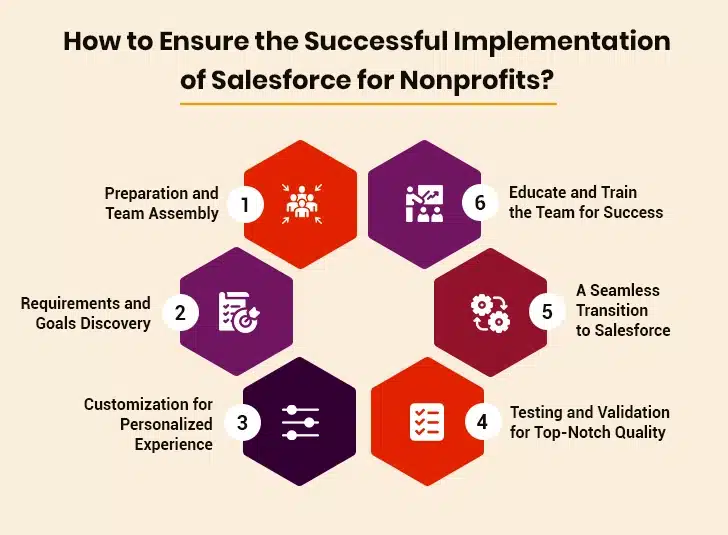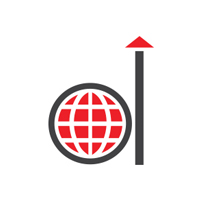Nonprofits run on a strong will to do good and passion, but passion alone doesn’t keep the donors engaged, funds flowing, and operations seamless. In a technology-driven world where efficiency and impact matter the most, nonprofit organizations find themselves navigating through a challenging landscape with a limited talent pool. Enter Salesforce— a CRM platform for corporate giants and a powerful ally for organizations dedicated to social causes and the overall development of society.

Table of Contents
Salesforce for Nonprofits: Why Is It Termed a Game Changer?
Key Features of Salesforce for Nonprofits
- I. Event Management Apps
- II. Marketing and Communications
- III. Case Management
- IV. Dashboards and Reports
Spring’ 25 Nonprofit Cloud Release: What’s New for Salesforce Nonprofit Users?
- Fundraising Enhancements
- Grantmaking Improvements
- Program and Case Management Updates
- Outcome Management Upgrades
The Guide to a Successful Salesforce Nonprofit Implementation Process
Salesforce for Nonprofits: Why Is It Termed a Game Changer?
Salesforce for Nonprofits is a complete ecosystem developed to meet the unique requirements of the social and charity sector. With Salesforce Nonprofit implementation partners and Nonprofit Success Pack (NPSP), charity organizations gain access to tools crafted for volunteer coordination, donation management, program delivery, and impact measurement—all through one unified system.
Imagine viewing a donor’s donation history, tracking grant deadlines automatically, and generating tailored impact reports in just a few clicks—that’s what Salesforce for Nonprofits does. But what makes it so effective, and how does Salesforce do it? Let’s discuss.
Salesforce for Nonprofits is essentially about people; it is about developing and nurturing strong connections with beneficiaries, donors, and volunteers. Consider this: every donation, every interaction, every hour spent by volunteers ? all captured and managed in one place. This data enables the management to personalize the outreach, tailor the donation programs, and eventually, make a bigger impact.
Salesforce centralizes all the data and offers a 360-degree view of each aspect, empowering charity organizations and NGOs to forge better relationships. Additionally, the robust reporting and analytics capabilities help measure and understand the impact with clarity. This transparency helps refine the strategies and build trust with donors and stakeholders to catalyze an expansive impact.
Key Features of Salesforce for Nonprofits
I. Event Management Apps
Salesforce consultants for Nonprofits help them move in the right direction with Salesforce’s Event Management apps. These apps show the location of donors on a map. Based on this data, NGOs can choose the location of their event. Additionally, these apps also allow one to store and manage data from anywhere and view real-time updates on guests as they check-in.
Such events may include tickets, passes, and mobile registrations. These apps are designed to quickly search such kind of donor data, collaborate on documents, update records, and view or edit event schedules.
Salesforce Event Management apps allow guests to create and manage their agendas. Attendees can share event pictures on social media and respond to surveys sent by NGOs. Through these apps, data from previous years’ events can be accessed for details on activities that garnered more participation, and which tickets sold fastest. Such data helps make changes to improve the event reach.
II. Marketing and Communications
Whether it is about spreading information about a new community service program or encouraging supporters for donations, marketing and communications impact growth strategies.
Email campaign management is a key process in this sector. Salesforce Nonprofit Success Pack facilitates automated email deliveries to hundreds of supporters, donors, volunteers, board members, and external parties. All these emails have added layers of features that enable easy tracking and management of the campaign, from sending to responding and undelivered emails. Once an email campaign is active, users can generate reports to check various metrics such as open rates, bounces, click-through rates, unsubscribes, delivery failures, clicks, and revenue generated.
III. Case Management
Salesforce Nonprofit’s Case Management feature helps manage and track each client case and associated interactions efficiently. It centralizes the entire case record, helps employees document services, schedules follow-ups, and measures the impact. With its automated workflows, various tasks, such as service referrals and appointment scheduling, are automated, reducing the administrative burden.
Salesforce Case Management also comes with built-in reporting. Nonprofits can assess program effectiveness, analyze trends, and ensure no clients fall through the cracks. Whether managing a large community program or supporting needy individuals, Salesforce Case Management can be easily structured to deliver highly personalized, data-driven care.
IV. Dashboards and Reports
Nonprofits have huge volumes of data in the form of donor and donation details, event data, campaign details, and others. To make the analysis meaningful and gain in-depth insights from this data, it is essential to have the data in a well-organized manner. Salesforce for Nonprofits includes different reporting application programming interfaces (APIs) that facilitate designing custom dashboards, business reporting, analytical applications, and visualizations.
These features allow various applications to be easily built within the Salesforce environment, a client-/cloud-based environment, or a spreadsheet. These dashboards and reports provide instant details on fundraising progress, donor acquisition, and survey responses.
Give Your Mission a New Direction with Salesforce for Nonprofits
Spring’ 25 Nonprofit Cloud Release: What’s New for Salesforce Nonprofit Users?
The Spring’25 Nonprofit Cloud release has brought various enhancements across the functionalities, with a focus on Grantmaking and Fundraising capabilities. These updates expand functionality, improve efficiency, and streamline nonprofit operations. Here are some key changes to keep an eye on:
Fundraising Enhancements
i) Custom Fields in Gift Entry: It is one of the most awaited enhancements. Earlier, out-of-the-box Gift Entry screens had certain limitations, forcing organizations to rely on workarounds. This release enables direct field mapping, resulting in more efficient data collection.
ii) Enhancements in Outreach Source Codes: There are two key improvements in Outreach Source Codes. The integration with Interest Tags will allow organizations to improve segmentation, resulting in better engagement and greater response rates. The auto-generation of source codes will reduce manual work and ensure consistent tracking of various outreach initiatives.
iii) Data Processing Engine Updates: There are two DPE updates to improve donor hand management. Soft credits are now in Donor Gift Summary rollups to provide a more comprehensive impact of the donation, capturing indirect contributions. Automated updates to definition templates ensure organizations use the most recent template configurations for DPE rollups.
iv) New Philanthropic Research Data Model: This new introduction includes a four-object data model to support in-depth tracking and assessment of the donor.
v) Enhanced Recency, Frequency, Monetary (RFM) Scoring: The RFM scoring system is tremendously improved as multiple source fields and objects can be used to determine scores. Organizations can establish custom weights for scoring parameters, allowing for strategic donor segmentation.
Grantmaking Improvements
i) Bulk Assignment of Application Reviewers: This is a new feature that allows reviewers to be assigned through list view button-triggered flows. This leads to improved efficiency and reduces time in grant application processing.
ii) Stage Management for Grantmaking: This powerful workflow is borrowed from the Financial Services Cloud. This tool automates and standardizes various approval processes across Grantmaking objects, including individual applications, budgets, application reviews, and funding awards.
Program and Case Management Updates
i) Care Plan Enhancements: This new update allows organizations to clone Care Plan templates while retaining their benefits and goals. This reduces redundancy when small modifications are made. This update also introduced support for tailored Care Plan goals, allowing for more personalized client support strategies.
Outcome Management Upgrades
The key upgrade in Outcome Management is the inclusion of a spreadsheet-like component for swiftly entering multiple indicator results, which simplifies bulk data entry and enhances accuracy.
The Guide to a Successful Salesforce Nonprofit Implementation Process
Kickstarting the implementation journey for Salesforce for Nonprofits may seem daunting. However, with the right Salesforce Nonprofit implementation partners, it is no less than a transformative step for a nonprofit organization. Here’s a simplified breakdown of the entire implementation process that ensures a clear roadmap to success.

Step 1: Preparation and Team Assembly
Similar to any other Salesforce implementation, the first step includes thorough preparation and assembling the right talent pool. This is the most crucial phase as it establishes the foundation of the entire project. Begin by identifying stakeholders within the organization who will be deeply involved in the process. They can be IT staff, leadership, project managers, and end users.
Hire Salesforce developers and align them with the team, set clear goals, and establish realistic timelines. Always remember, a well-structured and prepped team is half the work done in Salesforce implementation.
Step 2: Requirements and Goals Discovery
The second step involves digging out the organization’s specific goals and requirements. This stage ensures that the Salesforce implementation is well-aligned with the operational and mission requirements. Work closely with the Salesforce Nonprofit consultant to chalk down the current processes and pinpoint areas for improvement.
During this stage, ask critical questions, such as: What are the key fundraising challenges? How are donor relationships managed in the organization? What kind of reporting capabilities are needed? These answers help customize the Salesforce instance.
Step 3: Customization for Personalized Experience
With a clear vision of the requirements, this step involves customizing the Salesforce instance to match the nonprofit organization’s unique needs. And this is where Salesforce for Nonprofits shows its real capabilities. The platform offers a diverse range of customization options, from designing automated workflows for streamlined operations to creating custom fields and objects.
During this step, the Salesforce Nonprofit implementation partner configures the instance to match the organization’s structure, integrates it with existing systems and tools, and develops features to address unique needs.
Step 4: Testing and Validation for Top-Notch Quality
Once the Salesforce instance is configured, it is time to thoroughly test and validate the platform before going live. This stage is all about rigorous testing of customizations, integrations, and workflows to ensure their optimal performance.
Involve end-users in testing to gather their feedback and work on any usability challenges. This approach ensures that the configured instance truly meets the needs of individuals who will use it daily.
Step 5: A Seamless Transition to Salesforce
Data migration is an essential aspect of Salesforce implementation for Nonprofits. This phase involves transitioning existing business data from legacy systems to the Salesforce platform, while ensuring no data loss.
During this stage, pay close attention to data cleansing, mapping, and validation. Though time-consuming, a well-executed data migration sets the ground for a smooth transition and ensures the team has updated, accurate, and reliable data to work with in the new system.
Step 6: Educate and Train the Team for Success
Comprehensive education and training for all teams is the final step in the Salesforce for Nonprofits implementation process. Even the most customized and well-configured instance fails to deliver results if employees lack the essential knowledge to use the tool. Create a well-defined training plan encompassing the technical aspects of Salesforce and how its utilization in organization-specific processes can help the workforce.
Consider providing role-specific training sessions to each team to help them understand how Salesforce would impact on their daily work. Remember that training is an ongoing process and should never be considered a one-time activity.
By following a well-structured approach to Salesforce implementation, nonprofit organizations can ensure a seamless transition and put their organization on the path of success through this powerful platform. However, it is important to understand that implementing Salesforce isn’t just about deploying a new system, but also about transforming how nonprofits work and amplifying their impact.
Conclusion
As we’ve navigated through this article, it’s quite evident that Salesforce for Nonprofits is far more than just a technological upgrade— it is a strategic transformation that enables mission-driven charity organizations and NGOs to make a greater impact in society with limited resources. By streamlining operations, centralizing donor management, improving communication, and providing powerful analytics, Salesforce enables nonprofits to focus on what truly matters: serving their communities and spreading their cause.
The Spring’25 release further fortifies Salesforce’s ongoing commitment to the nonprofit sector with highly targeted enhancements for grantmaking, fundraising, and program management. While the implementation of the instance and new upgrades require meticulous planning and a sought-after implementation partner, the digital transformation journey is worth embarking on. In today’s exceedingly competitive and complex landscape, embracing Salesforce isn’t just about keeping with trends—it is about positioning the nonprofit organization for sustainable growth and optimal impact for years to come.





